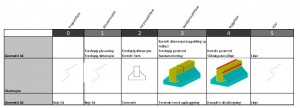The phases in the linked chart are connected to the Statsbygg project model
Curb (Curbstone)
A separation between two coverages, with its reveal below 50 cm. Normally, rails are not constructed on curbs. Reveal height (elevation between top of the curb edge top and the connected coverage area) may vary. In Norwegian databases for road and traffic planning it is defined as an object to separate traffic islands, sidewalks, roadway separators, etc.
Modelling
A curb should be able to be constructed as a separate object, drawn as a line with different modelling capabilities; straight, curved, angled, free formed and so on.
A curb should on several occasions be able to relate to other objects, such as a road line, whose distance and relation parameters in turn affects the curb geometry. In these cases, the road line is the host object. In other cases, the curb itself will serve as a host object for adjacent coverages or terrain.
Properties
A curb should be able to split a coverage into separate areas, which in turn should be able to be given different parameters, such as materials, thicknesses and/or surface composition.
A curb should be able to be exchanged with another object of the same type and immediately alter its geometry, while maintaining its position. The model line should be comparable to i.e. the wall line in Revit. In Revit, we are able to determine whether the wall object should be modelled with its line in center, on the outside or inside. The same options should be available to curbs. Also, when we alter the curb thickness, we should be able to choose in what direction it will be extended.
Geometry through project stages


Leave a Reply